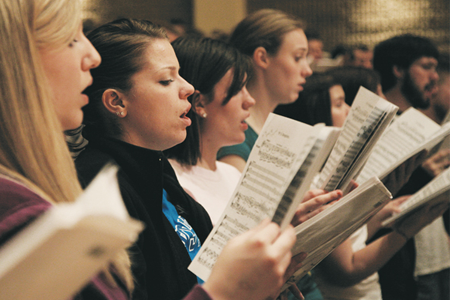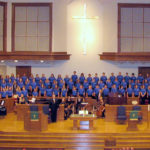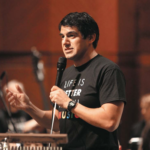As the new ministry season is upon us (or here for some of you), we have a stack of music to learn and a calendar with not enough rehearsal time. Let’s discuss ways to create a Master Plan for our rehearsals that can maximize our time both weekly and over the course of several weeks. It’s akin to creating the architectural blueprints for any building project. Building a house involves many steps stretched out over an extended period of time. Building a body of repertoire with a choir involves a similar process. We consider the age-old question: “How do you eat an elephant? One bite at a time.”
In assessing the long term of rehearsal planning, I have always found it best to look at the total number of rehearsals in a given season. This sounds obvious, but sometimes we overlook the obvious. Another way to look at this is to count the number of rehearsals leading up to a major performance. Now, some of you have choirs that sing every week. God bless you! As an example, however, let’s pretend that you are preparing for a major fall and/or Christmas presentation. Now work backwards as you set your rehearsal/teaching goals:
Starting with the end, dedicate your final two rehearsals prior to the performance as “run-through” rehearsals (from memory if possible). This way you build in some catch-up time if needed, but hopefully you can use this time to really polish and fine-tune your music. Ideally, this removes that feeling of coming “down to the wire” with getting music learned. As my mentor/teacher Dr. Gregory Fuller would say about the music learning process, “notes and rhythms are not a point of arrival; they are a point of departure.” This helps us ensure that we make that departure earlier in the rehearsal process.
Now with a tally of your remaining rehearsals in the back of your mind, go back to your stack of music and begin to examine each piece. Yes, this will take some time, but it is worth it in the end.
- Look at the piece and get the “bird’s-eye view.”
- Identify the overall form by marking the sections (label them with numbers or letters). Find places of exact repetition or repetition with slight variation (this is important later for memorization). Follow textual ideas to help you determine sections, e.g., stanzas of hymn texts, refrain, bridge, etc.
- Determine the difficulty of each section. (See 3-b for more detail.)
- Put the sections in order—hardest to easiest. I usually write this down on a sticky note that I put on the front cover of the piece. (This is also very important later.)
- Look for repeated rhythms or melodies in the music that you could use as warm-ups. The more you can get a rhythm or a tune in their ear, even before you look at the actual piece of music, the better the singers will retain it.
- Identify the difficulty of each section.
- Considering these issues: rhythm, melody/harmony, amount of words, frequency of changes in stylistic/expressive elements, etc.
- Sections that are repeated multiple times within a song do not need your immediate attention.
- Sections that are rhythmically difficult, extremes of vocal ranges/tessitura, lots of words, etc. need attention first. If there is a verse or chorus that is repeated with a slight change or if there is a key change, then ALL those things need your attention in your first rehearsals.
- Difficult sections need the most repetition over a period of weeks for it to really “settle in.” Maybe learn one easier passage first to get them into the music, but then move to the harder sections in rehearsals.
- Sections with a lot of text or changing text need your attention first. A chorus that repeats can wait.
- With those remaining rehearsals, jump to the beginning and begin to put together a “Master Plan” teaching sequence.
- To reiterate, your last rehearsal will/should always be a run-through of music (no rehearsing). You want to build in repetitions. The next-to-last rehearsal should NOT be the first time you put everything together OR the first time you try everything from memory; it needs to be the second or third time.
- With the remaining weeks, drop in the sections that you want to teach, starting with most difficult sections first and saving your easier sections towards the end.
- Each week should include reviewing the previous weeks’ new material, so include this in your rehearsals as you move forward. You MUST do this with a once-a-week choir. Only cover what you have time to review the next week.
- Example: Week 3, “Praise the Lord” (Handel), teach sections B/C, review D.
- Week 4, “Praise the Lord,” teach section A, review B, C, D.
- Keep chunking on new material while reviewing old material.
- As weeks go on, start trying to polish those sections that you have spent the most time on. You start learning less and less new material and building continuity with old material.
- As you go through this process, you might run into the issue that you do not have enough time for the music that you have selected. You might run into those run-through rehearsals and still have material that you need to teach. Suggestions:
- Go back to the break down of a few pieces and see if you can teach two or more new sections in the same rehearsal.
- Consider having a retreat weekend to get a jump start on all the new music.
- Do less music.
- Do easier music.
NOTE: Most often, the best way to work n any piece is simply back to front. This seems weird, but you always get to repeat material you have already worked on. It’s like starting with the caboose and adding a train car in front of it each week. With each new train car you can continue all the way to the end, building up consistent repetitions of the piece.
BONUS: If you take the time now to plan out all your weeks, week-to-week prep is not so bad. You have your master plan. And if something doesn’t go according to plan (which will happen) you have a plan from which to work.
*If you would like a sample of the result of this whole process, please email me. I’d be glad to send you my teaching sequence from when I prepared my student choir to sing at the YouthCue festival in DC back in 2012.










